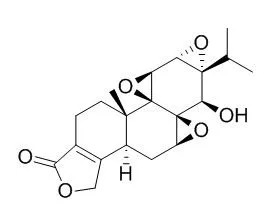| Description: |
Triptolide has immunosuppressive, anti-inflammatory, and anti-cancer activities, it induces apoptosis in tumor cells by blocking NF-KB activation and sensitizing tumor cells for TNF-a induced programmed cell death, it inhibits TGF-β1-induced cell proliferation and migration of rat airway smooth muscle cells, by suppressing Smad signaling and NF-κB ,respectively. Triptolide is an inhibitor of heat shock factor (HSF1), inhibits HSP90-CDC37 binding and induces acetylation of HSP90, and also inhibits MDM2 expression in a dose-dependent manner with IC50 values range from 47 to 73 nM. |
| Targets: |
NF-kB | IkB | p65 | TGF-β/Smad | ERK | IKK | HSF-1 | HSP90 | MDM2 |
| In vitro: |
| Biochem Biophys Res Commun. 2015 Jan 16;456(3):815-20. | | Triptolide inhibits proliferation of Epstein-Barr virus-positive B lymphocytes by down-regulating expression of a viral protein LMP1.[Pubmed: 25511707] | Epstein-Barr virus (EBV) infects various types of cells and mainly establishes latent infection in B lymphocytes. The viral latent membrane protein 1 (LMP1) plays important roles in transformation and proliferation of B lymphocytes infected with EBV. Triptolide is a compound of Tripterygium extracts, showing anti-inflammatory, immunosuppressive, and anti-cancer activities.
METHODS AND RESULTS:
In this study, it is determined whether Triptolide inhibits proliferation of Epstein-Barr virus-positive B lymphocytes. The CCK-8 assays were performed to examine cell viabilities of EBV-positive B95-8 and P3HR-1 cells treated by Triptolide. The mRNA and protein levels of LMP1 were examined by real time-PCR and Western blotting, respectively. The activities of two LMP1 promoters (ED-L1 and TR-L1) were determined by Dual luciferase reportor assay. The results showed that Triptolide inhibited the cell viability of EBV-positive B lymphocytes, and the over-expression of LMP1 attenuated this inhibitory effect. Triptolide decreased the LMP1 expression and transcriptional levels in EBV-positive B cells. The activity of LMP1 promoter ED-L1 in type III latent infection was strongly suppressed by Triptolide treatment. In addition, Triptolide strongly reduced growth of B95-8 induced B lymphoma in BALB/c nude mice.
CONCLUSIONS:
These results suggest that Triptolide decreases proliferation of EBV-induced B lymphocytes possibly by a mechanism related to down-regulation of the LMP1 expression. | | J Exp Clin Cancer Res . 2021 Jun 9;40(1):190. | | Natural product triptolide induces GSDME-mediated pyroptosis in head and neck cancer through suppressing mitochondrial hexokinase-ΙΙ[Pubmed: 34108030] | | Abstract
Background: Pyroptosis is a lytic cell death form executed by gasdermins family proteins. Induction of tumor pyroptosis promotes anti-tumor immunity and is a potential cancer treatment strategy. Triptolide (TPL) is a natural product isolated from the traditional Chinese herb which possesses potent anti-tumor activity in human cancers. However, its role in pyroptosis remains to be elucidated.
Methods: Cell survival was measured by colony formation assay. Cell apoptosis was determined by Annexin V assay. Pyroptosis was evaluated by morphological features and release of interleukin 1β and lactate dehydrogenase A (LDHA). Immunofluorescence staining was employed to measure subcellular localization of proteins. Tumorigenicity was assessed by a xenograft tumor model. Expression levels of mRNAs or proteins were determined by qPCR or western blot assay, respectively.
Results: Triptolide eliminates head and neck cancer cells through inducing gasdermin E (GSDME) mediated pyroptosis. Silencing GSDME attenuates the cytotoxicity of TPL against cancer cells. TPL treatment suppresses expression of c-myc and mitochondrial hexokinase II (HK-II) in cancer cells, leading to activation of the BAD/BAX-caspase 3 cascade and cleavage of GSDME by active caspase 3. Silencing HK-II sensitizes cancer cells to TPL induced pyroptosis, whereas enforced expression of HK-II prevents TPL induced pyroptosis. Mechanistically, HK-II prevents mitochondrial translocation of BAD, BAX proteins and activation of caspase 3, thus attenuating cleavage of GSDME and pyroptosis upon TPL treatment. Furthermore, TPL treatment suppresses NRF2/SLC7A11 (also known as xCT) axis and induces reactive oxygen species (ROS) accumulation, regardless of the status of GSDME. Combination of TPL with erastin, an inhibitor of SLC7A11, exerts robust synergistic effect in suppression of tumor survival in vitro and in a nude mice model.
Conclusions: This study not only provides a new paradigm of TPL in cancer therapy, but also highlights a crucial role of mitochondrial HK-II in linking glucose metabolism with pyroptosis.
Keywords: Ferroptosis; Gasdermins; Head and neck squamous cell carcinoma; Nasopharyngeal carcinoma; X(c)(−) cysteine/glutamate antiporter. |
|
| In vivo: |
| Mol Cell Endocrinol. 2015 Jan 5;399:346-53. | | Triptolide inhibits osteoclast formation, bone resorption, RANKL-mediated NF-қB activation and titanium particle-induced osteolysis in a mouse model.[Pubmed: 25448849] | The RANKL-induced NF-κB signaling pathway is required for osteoclast formation and function.
METHODS AND RESULTS:
By screening for compounds that inhibit RANKL-induced NF-κB activation using a luciferase reporter gene assay in RAW264.7 cells, we identified Triptolide (PG490), as a candidate compound targeting osteoclast differentiation and osteoclast-mediated osteolysis. Triptolide (PG490) is an active compound of the medicinal herb Tripterygium wilfordii Hook F (TWHF) or Lei Gong Teng with known anti-inflammatory properties. We found that Triptolide inhibited osteoclastogenesis and bone resorption, as well as RANKL-induced NF-қB activities as monitored by luciferase reporter gene assays and the nuclear translocation of p65. In vivo studies showed that Triptolide attenuates titanium-induced osteolysis and osteoclast formation in a mouse calvarial model.
CONCLUSIONS:
Considering that drugs which protect against localized bone loss are critically needed for the effective treatment of particle-induced osteolysis, our data suggest that Triptolide might have therapeutic potential for the treatment of bone lytic diseases caused by prosthetic wear particles. |
|






 Cell. 2018 Jan 11;172(1-2):249-261.e12. doi: 10.1016/j.cell.2017.12.019.IF=36.216(2019)
Cell. 2018 Jan 11;172(1-2):249-261.e12. doi: 10.1016/j.cell.2017.12.019.IF=36.216(2019) Cell Metab. 2020 Mar 3;31(3):534-548.e5. doi: 10.1016/j.cmet.2020.01.002.IF=22.415(2019)
Cell Metab. 2020 Mar 3;31(3):534-548.e5. doi: 10.1016/j.cmet.2020.01.002.IF=22.415(2019) Mol Cell. 2017 Nov 16;68(4):673-685.e6. doi: 10.1016/j.molcel.2017.10.022.IF=14.548(2019)
Mol Cell. 2017 Nov 16;68(4):673-685.e6. doi: 10.1016/j.molcel.2017.10.022.IF=14.548(2019)